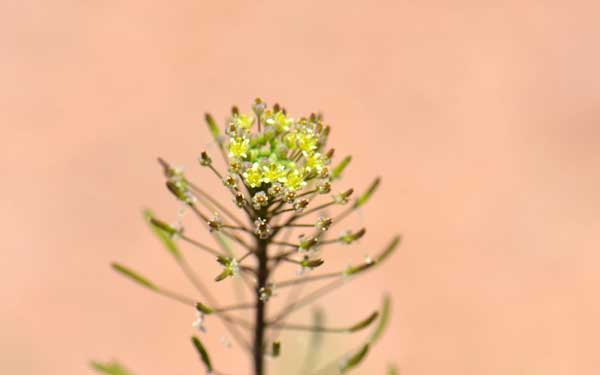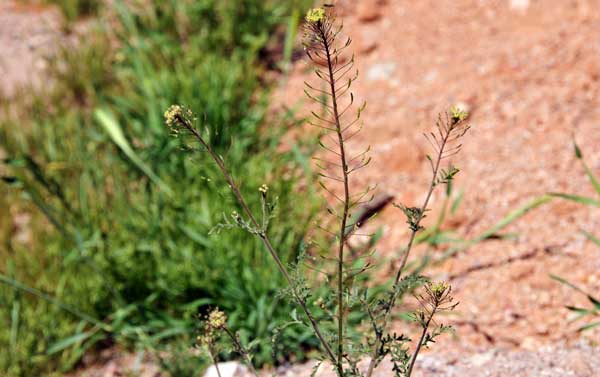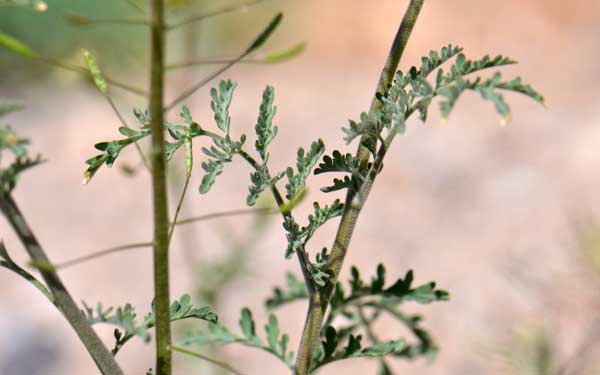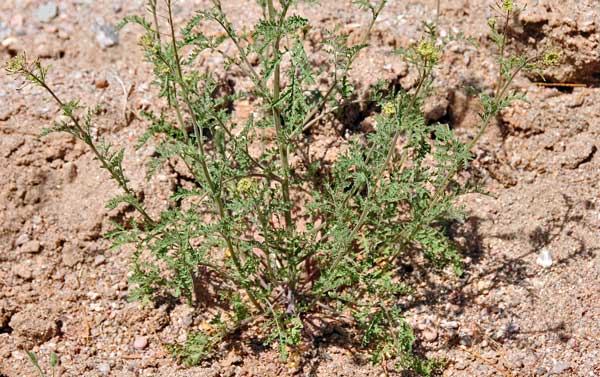Descurainia pinnata, Western Tansymustard




Scientific Name: Descurainia pinnata
Common Name: Western Tansymustard
Also Called: Green Tansymustard, Pinnate Tansy Mustard, Pinnate Tansymustard, Tansy Mustard, Tansymustard Yellow Tansy Mustard (Spanish: Pamita, Pamitón)
Family: Brassicaceae or Cruciferae, Mustard Family
Synonyms: (Sophia pinnata, Descurainia pinnata var. brachycarpa)
Status: Native
Duration: Annual, biennial or seldom a perennial.
Size: Up to 2 feet, usually smaller.
Growth Form: Forb/herb; variable, erect, basal leaves, one or more stems, slender branching stems.
Leaves: Green; pinnately lobed or divided 1 or more times, basal leaves drying during bloom period.
Flower Color: Yellow or yellow-whitish; 4 petals and 4 sepals, small flowers clustered on tips of slender branches; fruit is a long rounded capsule referred to as a silique on a slender stem or pedicel .
Flowering Season: Spring and early summer.
Elevation: Up to 7,000 feet.
Habitat Preferences: Variable habitats; disturbed areas, mesas, sandy soils and along riparian areas throughout the state.
Recorded Range: Western Tansymustard is found throughout North America.
North America & US County Distribution Map for Descurainia pinnata.
U.S. Weed Information: Descurainia pinnata is listed in: Weeds of Nebraska and the Great Plains and Weeds of the United States and Canada. Plants included here may become weedy or invasive.
Invasive/Noxious Weed Information:
Wetland Indicator:
Threatened/Endangered Information: The state of Ohio has listed (Descurainia pinnata as Threatened.
Genus Information: 8 species in Descurainia in North America. It is native throughout Arizona. There are 10 subspecies in Descurainia pinnata,
5 subspecies in Arizona;
Descurainia pinnata ssp. filipes, Western Tansymustard;
Descurainia pinnata ssp. glabra, Western Tansymustard;
Descurainia pinnata ssp. halictorum, Western Tansymustard;
Descurainia pinnata ssp. ochroleuca, Western Tansymustard and
Descurainia pinnata ssp. paysonii, Payson's Tansymustard.
Comments: Western Tansymustard is so named because of the leaf margins which are pinnately lobed or divided 1 or more times. Of interest is that is considered a weed by some authorities and at the same time listed as "Threatened" by Ohio.
Western Tansymustard has low value for wildlife but its flowers attract insects, butterflies in particular.
Several ethno-botanical uses have been identified for Western Tansymustard including grinding the seeds up for use in stomach ailments and an application of a poultice of the plant for toothaches. See the full species account from Native American Ethnobotany, University of Michigan, Dearborn.

